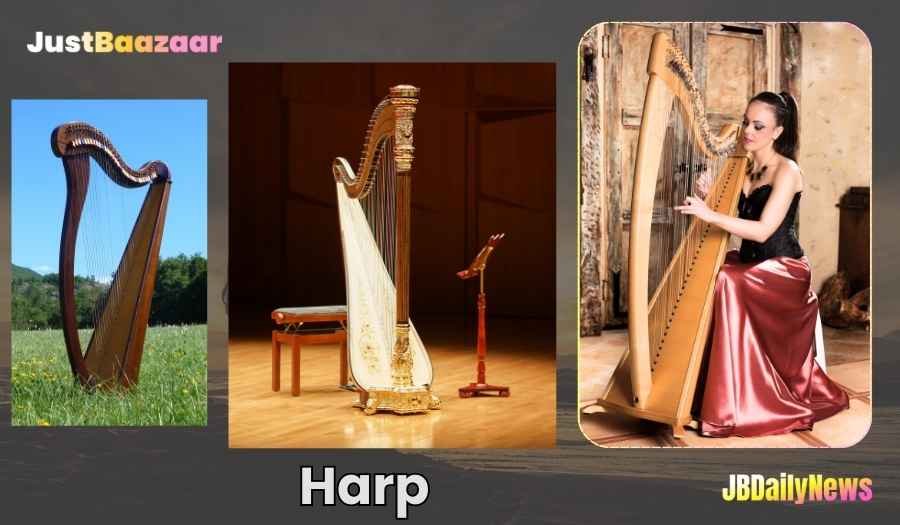The harp is a stringed musical instrument known for its ethereal and enchanting sound, often associated with classical, Celtic, and folk music. Recognizable by its graceful triangular frame, the harp has a long history and unique mechanics that have captivated listeners for centuries. This guide explores how the harp works, its history, uses, and more.

1. How the Harp Works
The harp produces sound through the vibration of strings stretched across a resonant frame. It is a plucked string instrument, meaning the musician uses fingers to pluck each string individually, creating a wide range of pitches.
- Frame: The harp has a characteristic triangular shape, with a soundboard at the base that amplifies the sound.
- Strings: Each string is responsible for one specific pitch. In larger harps, the strings are color-coded to help harpists quickly identify notes.
- Pedals or Levers: Some harps feature pedals or levers that alter the pitch of specific strings, allowing for chromatic versatility.
2. The Harp’s Types and Sizes
Harps vary widely in size and style, each suited to different genres or playing styles:
- Concert Harp: The largest type, often used in classical music, with a pedal mechanism for changing pitch.
- Lever Harp: Smaller and lighter than a concert harp, commonly used in folk and Celtic music.
- Lyre Harp: A smaller, ancient type of harp, often associated with ancient Greek culture and music.
3. The History of the Harp
The harp has one of the longest histories of any musical instrument, dating back to ancient civilizations:
- Ancient Beginnings: Harp-like instruments were found in Mesopotamia, Egypt, and Persia around 3000 BCE. These early harps were simple, often with just a few strings.
- Medieval and Renaissance Periods: In Europe, the harp became a favored instrument in the Middle Ages, particularly in Celtic and Norse cultures.
- Development of the Pedal Harp: In the 18th century, the pedal harp was invented, allowing for more complex music and easier pitch changes, marking a turning point in classical harp music.
4. Uses of the Harp
The harp has a broad appeal and is used in various musical contexts due to its rich, resonant sound:
- Classical Music: Commonly used in orchestras and solo performances, the concert harp brings a unique color and texture to compositions.
- Folk and Traditional Music: Lever harps are often used in Celtic, Irish, and folk music.
- Contemporary Music: The harp has found its place in jazz, pop, and even some rock genres, adding a unique and atmospheric sound.
5. Harp as an Adjective: “Harp-Like”
The term “harp-like” is often used to describe sounds or shapes resembling the harp’s gentle, flowing nature. Examples include:
- “Her harp-like voice resonated beautifully in the cathedral.”
- “The river’s harp-like currents reflected the golden sunlight.”
6. Harp as a Word: Pronunciation, Spelling, and Etymology
- Pronunciation: The harp is pronounced /hɑːrp/.
- Spelling: H-a-r-p.
- Etymology: The term “harp” originates from the Old English “hearpe” and Old Norse “harpa.” It has cognates in various languages, reflecting its widespread use in ancient cultures.
7. The Harp Family
The harp is part of a broader family of plucked string instruments, many of which share similar mechanics but vary in style and cultural significance. Members include:
- The Lyre: A smaller, ancient instrument with fewer strings, commonly used in early Greek and Roman music.
- The Kora: A West African harp-lute with 21 strings, used in traditional West African music.
8. The Harp in HTML
In the digital world, the term “harp” doesn’t have a direct meaning in HTML, but the concept of creating harmonious, pleasing designs can be seen in web elements where aesthetic and functionality come together. For example, an HTML audio player that allows for smooth, flowing interaction could be described as “harp-like” for its appeal to the senses.
9. Is the Harp Difficult to Play?
The harp is challenging to learn due to its unique structure and technical demands:
- Coordination: Harpists use both hands to pluck strings while adjusting pedals or levers, requiring significant multitasking.
- Dexterity: Harpists develop calluses to navigate the strings more comfortably and quickly.
Though initially challenging, the harp is rewarding for its expansive range of expression and versatility in different music genres.
10. Is the Harp Like a Guitar?
The harp and guitar are both plucked string instruments but have distinct differences:
- Harp: Stands vertically with strings that are tuned diatonically (like a piano). It is played using finger plucking on strings of different lengths.
- Guitar: Held horizontally and uses a fretboard to produce various pitches on each string.
11. Country of Origin
The harp is among the oldest instruments and has no specific country of origin. It was first documented in Mesopotamia, Egypt, and Persia. From there, it spread across various cultures, including ancient Greece and the Celtic lands, evolving into the modern versions we see today.
Conclusion: The harp’s timeless beauty, deep historical roots, and versatility make it one of the most cherished and unique instruments in the world. From the concert hall to folk gatherings, its graceful melodies continue to captivate audiences across genres.
Read History of Music













